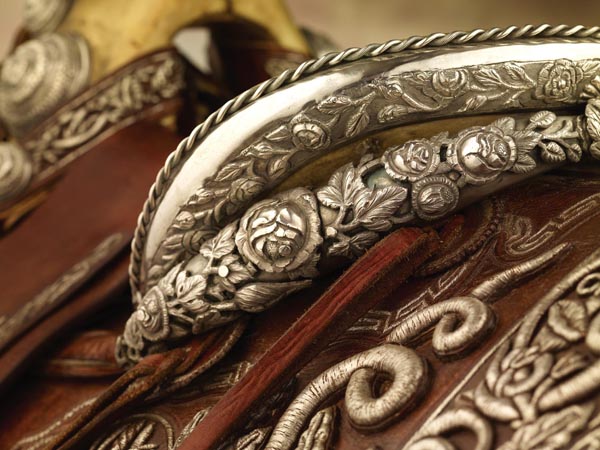
 Pancho Villa’s Last Saddle
Pancho Villa’s Last Saddle
The last saddle owned by Pancho Villa will be for sale at the High Noon Western Americana auction this January.
Almost 100 years ago the infamous Pancho Villa, hero & outlaw, was assassinated in Hidalgo del Parral, Mexico, a short distance from his hacienda. What remains are not only the facts but also the folklore of his life, along with this magnificent silver threaded saddle, his last. It will be offered for public sale, to be sold at auction on January 28, 2012 at the High Noon Western Americana auction, in Mesa, AZ. This famous and historical item is estimated to bring between $150,000-250,000.
 The saddle’s colorful history also blends with Hollywood mystique. It was presented to Howard Hawks in 1931 by Senora Maria Luz Corral de Villa, Pancho’s widow, a woman with a twinkle in her eyes and memories of revolutionary campfires dancing in her head. His only legal wife out of 8 or more wives (or what passed for marriage) she was in love with him for six decades. When Hollywood knocked on the door to make a film Viva Villa, with famed director Howard Hawks the first at its helm, he met Senora Villa. After being excused from filming, she presented the glorious saddle to him as a gift because she felt the film extolled the Mexican Revolution and Villa himself.
The saddle’s colorful history also blends with Hollywood mystique. It was presented to Howard Hawks in 1931 by Senora Maria Luz Corral de Villa, Pancho’s widow, a woman with a twinkle in her eyes and memories of revolutionary campfires dancing in her head. His only legal wife out of 8 or more wives (or what passed for marriage) she was in love with him for six decades. When Hollywood knocked on the door to make a film Viva Villa, with famed director Howard Hawks the first at its helm, he met Senora Villa. After being excused from filming, she presented the glorious saddle to him as a gift because she felt the film extolled the Mexican Revolution and Villa himself.
 Villa was both charismatic hero and cruel outlaw, a warlord who survived countless battles and assassinations of 3 strong Mexican revolutionary leaders Madero, Zapata and Carranza. Stories of his life helped define the spirit of his country’s struggle for freedom. His place in history is a paradox: a revolutionary idealist who believed firmly in public education, health
Villa was both charismatic hero and cruel outlaw, a warlord who survived countless battles and assassinations of 3 strong Mexican revolutionary leaders Madero, Zapata and Carranza. Stories of his life helped define the spirit of his country’s struggle for freedom. His place in history is a paradox: a revolutionary idealist who believed firmly in public education, health  and good government, and a vicious, mean-spirited, cruel revolutionary who would do anything to win. His legend is a complex mosaic of folklore and fact, including stories of treasures, said to have been buried by him somewhere in the Mexican desert.
and good government, and a vicious, mean-spirited, cruel revolutionary who would do anything to win. His legend is a complex mosaic of folklore and fact, including stories of treasures, said to have been buried by him somewhere in the Mexican desert.
The saddle, in excellent condition, is smothered in silver-wrapped threads and boldly-domed silver  conchos. Made and marked by expert craftsmen, it has Francisco (nickname: Pancho) Villa’s initials in high relief on the stirrups. Thematically it has a 3-dimensional silver snakehead and a carved Diablo in the leather under the grand saddlebags.
conchos. Made and marked by expert craftsmen, it has Francisco (nickname: Pancho) Villa’s initials in high relief on the stirrups. Thematically it has a 3-dimensional silver snakehead and a carved Diablo in the leather under the grand saddlebags.
The saddle had been on display for almost 20 years at the both Witte Museum in San Antonio, TX and the South Texas History Museum in Edinburg, TX (between 1990-2009) and will now be offered at sale through High Noon Western Americana on January 28 in Arizona.

If problems with website occur, please contact the webmaster. Site designed by Ireland Graphic Design.

